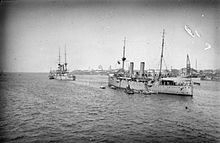Astraea-class cruiser

| |
| Class overview | |
|---|---|
| Name | Astraea |
| Operators | |
| Preceded by | Apollo class |
| Succeeded by | Eclipse class |
| Built | 1893–1896 |
| In commission | 1894–1923 |
| Completed | 8 |
| Retired | 8 |
| General characteristics | |
| Type | protected cruiser |
| Displacement | 4,360 tons |
| Length | |
| Beam | 49 ft 6 in (15.09 m) |
| Draught | 19 ft (5.8 m) |
| Propulsion |
|
| Speed |
|
| Range |
|
| Complement | 318 |
| Armament |
|
| Armour |
|
The Astraea class was an eight ship class of
the Marine Society
and used as a training ship until 1940.
Design and construction

Right elevation, deck plan and hull section as depicted in Brassey's Naval Annual 1897
The eight ships were ordered under the provisions of the
seaworthy, and the design provided the basis for the development of future protected cruisers.[1] The ships were built at several of the principal navy dockyards: three at Devonport, two at Pembroke, and one each at Sheerness, Chatham and Portsmouth.[1]
Service
All eight ships spent at least some time on foreign stations, particularly in the Indian and Pacific Oceans, and despite their obsolescence, all but
China Station and in the Indian Ocean, before joining the Grand Fleet at the Nore in 1912.[3] She moved to the Cape of Good Hope and West African Station in 1913, and spent the war there, bombarding Dar es Salaam and taking part in the blockade of Königsberg.[3] She was paid off after the war and was sold in 1920.[5] Cambrian served on the Australia Station and in the Indian Ocean, before returning to Britain in 1913 to be paid off and put up for sale.[3] The outbreak of the First World War led to the navy retaining her and commissioning her as a stoker's training ship named Harlech in 1916.[3][6] She was renamed Vivid in 1921 and was sold in 1923.[6]

Charybdis spent most of her career in British waters, with occasional voyages to the Indian Ocean and Far East commands.
Ships

| Name | Builder | Laid down | Launched | Completed | Fate | |||
|---|---|---|---|---|---|---|---|---|
| Astraea | Devonport Dockyard | 17 March 1893 | 5 November 1895 | Sold in 1920 | ||||
| Bonaventure | Devonport Dockyard | 2 December 1892 | 5 July 1894 | Sold in 1920 | ||||
| Cambrian | Pembroke Dockyard | 30 January 1893 | Sold in 1923 | |||||
| Charybdis | Sheerness Dockyard | 1891 | 15 June 1893 | 14 January 1896 | Sold in 1922 | |||
| Flora | Pembroke Dockyard | 21 November 1893 | Sold in 1923 | |||||
| Forte | Chatham Dockyard | 9 December 1893 | Sold in 1914 | |||||
| Fox | Portsmouth Dockyard | 15 June 1893 | 14 April 1896 | Sold in 1920 | ||||
| Hermione | Devonport Dockyard | 7 November 1893 | 14 January 1896 | Sold in 1940 | ||||
| Sources: Conway's 1860–1905, p. 77; Jane's, p. 62 | ||||||||
Notes
- ^ a b c d e f g Gardiner (ed.). Conway's All the World's Fighting Ships 1860–1905. p. 77.
- ^ a b Colledge. Ships of the Royal Navy. p. 44.
- ^ a b c d e f g h i j k l m n o Gardiner (ed.). Conway's All the World's Fighting Ships 1906–1921. p. 15.
- ^ Fighting Ships of World War I. p. 90.
- ^ a b Colledge. Ships of the Royal Navy. p. 24.
- ^ a b Colledge. Ships of the Royal Navy. p. 58.
- ^ Colledge. Ships of the Royal Navy. p. 67.
- ^ Colledge. Ships of the Royal Navy. p. 128.
- ^ Colledge. Ships of the Royal Navy. p. 131.
- ^ Colledge. Ships of the Royal Navy. p. 133.
- ^ a b c Colledge. Ships of the Royal Navy. p. 162.
References
- ISBN 978-1-86176-281-8.
- Gardiner, Robert; Chesneau, Roger; Kolésnik, Eugène M.; Campbell, N. J. M. (1979). Conway's All the World's Fighting Ships 1860–1905. Conway. ISBN 0-85177-133-5.
- Gardiner, Robert; Gray, Randal; Budzbon, Przemysław (1985). Conway's All the World's Fighting Ships 1906–1921. Conway. ISBN 0-85177-245-5.
- ISBN 0-517-03375-5.
External links
Wikimedia Commons has media related to Astraea class cruiser (1893).
